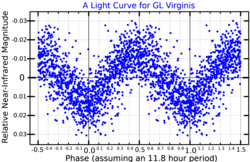处女座GL
处女座GL,亦可称为G 12-30, 是一颗位于处女座微弱的红矮星,与太阳系10秒差距内的70%以上的恒星一样;它的视星等为13.898,肉眼无法看到。
| 观测资料 历元 J2000 | |
|---|---|
| 星座 | 处女座 |
| 星官 | |
| 赤经 | 12h 18m 59.3999s[2] |
| 赤纬 | +11° 07′ 33.7702″[2] |
| 视星等(V) | 13.898[3] |
| 特性 | |
| 光谱分类 | M5[4] |
| U−B 色指数 | +1.065[5] |
| B−V 色指数 | +1.88[5] |
| 变星类型 | 耀星 |
| 天体测定 | |
| 径向速度 (Rv) | 5.82[3] km/s |
| 自行 (μ) | 赤经:−1269.771±0.056[6] mas/yr 赤纬:203.444±0.033[6] mas/yr |
| 视差 (π) | 154.6999 ± 0.0445[6] mas |
| 距离 | 21.083 ± 0.006 ly (6.464 ± 0.002 pc) |
| 绝对星等 (MV) | 14.72[7] |
| 详细资料 | |
| 质量 | 0.12[7] M☉ |
| 半径 | 0.16[8] R☉ |
| 表面重力 (log g) | 5.0[9] |
| 温度 | 3110[9] K |
| 金属量 [Fe/H] | 0.17[10] dex |
| 自转速度 (v sin i) | 17[8] km/s |
| 其他命名 | |
| 参考数据库 | |
| SIMBAD | 资料 |
处女座 GL 位于21.1光年外,光谱类型为M4.5V,温度为3110 K.[9]与太阳相比,它的光度(在电磁波谱的可见部分发出)只有十分之一; 然而,由于其辐射的很大一部分是以不可见红外光的形式发射的,因此其辐射光度会增加到太阳光度的 0.5%。质量为太阳的12%[7],半径为太阳的16%[8]。它的自转速度至少为17 km/s[8],这意味着它只需要不到半天的时间完成自转一圈。这颗恒星经常发出耀斑,直至2019年至少检测到五次。[4]
参考 编辑
- ^ Díez Alonso, E.; Caballero, J. A.; Montes, D.; de Cos Juez, F. J.; Dreizler, S.; Dubois, F.; Jeffers, S. V.; Lalitha, S.; Naves, R.; Reiners, A.; Ribas, I.; Vanaverbeke, S.; Amado, P. J.; Béjar, V. J. S.; Cortés-Contreras, M.; Herrero, E.; Hidalgo, D.; Kürster, M.; Logie, L.; Quirrenbach, A.; Rau, S.; Seifert, W.; Schöfer, P.; Tal-Or, L. CARMENES input catalogue of M dwarfs. IV. New rotation periods from photometric time series. Astronomy and Astrophysics. January 2019, 621: A126. Bibcode:2019A&A...621A.126D. doi:10.1051/0004-6361/201833316 .
- ^ 2.0 2.1 Brown, A. G. A.; Vallenari, A.; Prusti, T.; de Bruijne, J. H. J.; et al. Gaia Data Release 2. Summary of the contents and survey properties. Astronomy & Astrophysics. 2018. Bibcode:2018A&A...616A...1G. arXiv:1804.09365 . doi:10.1051/0004-6361/201833051. VizieR中此天体在盖亚望远镜第二批数据发布的记录
- ^ 3.0 3.1 3.2 [ V* GL Vir] 请检查
|url=值 (帮助). SIMBAD. 斯特拉斯堡天文资料中心. - ^ 4.0 4.1 Rodríguez Martínez, Romy; Lopez, Laura A.; Shappee, Benjamin J.; Schmidt, Sarah J.; Jayasinghe, Tharindu; Kochanek, Christopher S.; Auchettl, Katie; Holoien, Thomas W.-S., A Catalog of M-dwarf Flares with ASAS-SN, The Astrophysical Journal, 2019, 892 (2): 144, S2CID 209323915, arXiv:1912.05549 , doi:10.3847/1538-4357/ab793a
- ^ 5.0 5.1 Mermilliod, J.-C. Compilation of Eggen's UBV data, transformed to UBV (unpublished). Catalogue of Eggen's UBV Data. 1986 [2023-03-22]. Bibcode:1986EgUBV........0M. (原始内容存档于2019-12-08).
- ^ 6.0 6.1 6.2 Brown, A. G. A.; et al. Gaia Early Data Release 3: Summary of the contents and survey properties. Astronomy & Astrophysics. 2021, 649: A1. Bibcode:2021A&A...649A...1G. S2CID 227254300. arXiv:2012.01533 . doi:10.1051/0004-6361/202039657 . 已忽略未知参数
|collaboration=(帮助) (勘误: doi:10.1051/0004-6361/202039657e). Gaia EDR3 record for this source at VizieR. - ^ 7.0 7.1 7.2 The One Hundred Nearest Star Systems. 2012 [25 December 2016]. (原始内容存档于2012-03-26).
- ^ 8.0 8.1 8.2 8.3 Reiners, Ansgar; Basri, Gibor; Browning, Matthew. Evidence for Magnetic Flux Saturation in Rapidly Rotating M Stars (PDF). The Astrophysical Journal. 2009, 692 (1): 538–545 [2021-09-11]. Bibcode:2009ApJ...692..538R. S2CID 15833388. arXiv:0810.5139 . doi:10.1088/0004-637X/692/1/538. hdl:10871/10302. (原始内容存档 (PDF)于2021-09-11).
- ^ 9.0 9.1 9.2 Lépine, Sébastien. A Spectroscopic Catalog of the Brightest (J < 9) M Dwarfs in the Northern Sky. The Astronomical Journal. 2013, 145 (4): 102. Bibcode:2013AJ....145..102L. S2CID 117144290. arXiv:1206.5991 . doi:10.1088/0004-6256/145/4/102.
- ^ Newton, Elisabeth R. Near-infrared Metallicities, Radial Velocities, and Spectral Types for 447 Nearby M Dwarfs. The Astronomical Journal. 2014, 147 (1): 20. Bibcode:2014AJ....147...20N. S2CID 26818462. arXiv:1310.1087 . doi:10.1088/0004-6256/147/1/20.
- ^ Stars within 15 light-years of Gliese & Jahreiss 1156 (The Internet Stellar Database)
